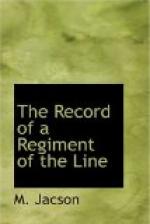“Good morning Mr. Franchise,
don’t be so
cowardly to stay in holes,
ye brave hero.
“Your
faithfully,
“SMALL
LONG TOM.”
Another blind shell picked up was full of sweetmeats.
Messages of good wishes to the garrison were received from Her Majesty, from Sir Redvers Buller, and from the soldiers, sailors, and civilians of Hong Kong.
Sir George White came round to see the Regiment in the evening, and informed the officers that Sir Redvers Buller would make no move for a fortnight. This was definite news, at any rate.
At dawn on January 3rd most of the naval guns fired off a large amount of shell, and there was considerable guessing amongst the uninitiated as to what was or were the targets. Shells fell at the foot of Bulwana, near the searchlight on the top, and also near the big gun. It was afterwards learnt that all the shells were meant for one particular spot on Bulwana, viz. the big gun.
On occasions it was the duty of the Regiment to send one company to dismount the 4.7 gun known as “Lady Anne” and place it on carts preparatory to its being shifted elsewhere. This was easily accomplished at the commencement of the siege in one night by 100 men. At the end of the siege, however, owing to the weakness of the men, the task was never completed under two nights, and then by 200 men.
About this time one company of the Regiment was ordered down to the railway station as a station and bridge guard. This was a three-days’ post, and was much appreciated, as the men, being quite concealed amongst trees, had more freedom, and the officer in command had a railway carriage to sleep in.
On January 5th the following moves took place, and as the position of companies is important, they are given in full.
Three companies proceeded under Major Curry to Observation Hill to relieve the companies of the 60th Rifles ordered to Caesar’s Camp. One company was ordered to the railway station as bridge guard. A half company was sent to form the Bell’s Spruit picquet, the other half remaining at the Railway Cutting. In the early hours of January 6th three fresh companies relieved those on Observation Hill, the latter returning to the Railway Cutting; the two companies at the railway bridge and at Bell’s Spruit stood fast in their positions of the previous day.
The Boer attack of January 6th on the positions round Ladysmith commenced on Wagon Hill at about 2.45 a.m., and the Boers were not finally repulsed till after dark on the evening of the same day.
As the great attack has been so ably described by various authors, it will suffice here to give a rough outline of what took place on Caesar’s Camp and Wagon Hill prior to the companies of the Regiment reaching the latter place.
The Boers attacked Wagon Hill at about 2.45 a.m., and amidst a good deal of confusion on the top, where 4:7 gun was in the act of being mounted, gained possession of the front crest. Their attempt to take Wagon Hill itself failed. Reinforcements consisting of two companies Gordon Highlanders and three squadrons of I.L.H. were sent to assist the 60th Rifles, the men of the I.L.H., and the detachment of Sappers already engaged with the Boers.




